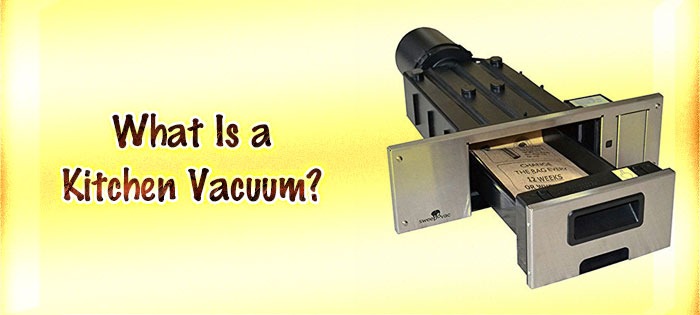Are Smart Kitchen Sinks Worth It?

Smart kitchen sinks are worth the investment if you're looking to modernize your kitchen with practical benefits. You'll enjoy touchless operation that reduces cross-contamination and automated features that can save up to 7,000 gallons of water annually. These smart fixtures enhance your daily routine with voice controls, precise temperature settings, and self-cleaning capabilities that make kitchen tasks more efficient. While they require professional installation and come at a premium price point, the long-term savings on water bills and maintenance costs, combined with increased property value, make them a smart choice. Let's investigate the specific features that could alter your kitchen experience.
Understanding Smart Kitchen Sink Technology
Innovation in kitchen technology has revolutionized even the humble sink. Today's smart kitchen sinks combine sophisticated features that alter your daily kitchen tasks into seamless, efficient operations. Through touchless technology and motion sensors, you'll experience hands-free control that prevents cross-contamination and maintains better hygiene standards while cooking or cleaning.
These advanced sinks aren't just about convenience; they're packed with practical features that make a real difference. You'll find precise temperature control systems that deliver water at exactly the temperature you need, while built-in water conservation features help you track and reduce your water usage. The integration of water filtration systems means you'll have instant access to purified water without cluttering your counter with separate filtering devices.
Voice activation capabilities allow you to control your sink through simple commands, whether you're asking for specific water amounts or temperature settings. What's more, these sinks connect seamlessly with your existing smart home system, enabling you to monitor and control your sink remotely. This smart home integration creates a cohesive kitchen ecosystem where your sink works in harmony with other connected appliances.
Key Features and Benefits
Versatility stands out as the defining characteristic of smart kitchen sinks, with features that alter everyday tasks into efficient, automated experiences. Through touchless technology and precise temperature control, you'll find yourself managing water flow with unparalleled ease while maintaining ideal hygiene standards. These smart features don't just streamline your kitchen tasks; they're designed to promote environmental conservation through advanced water conservation mechanisms.
When you invest in a smart kitchen sink, you'll benefit from:
- Enhanced hygiene through touchless operation, reducing cross-contamination and keeping your kitchen environment healthier
- Reduced utility costs thanks to efficient water conservation features and precise temperature control
- Time savings with automated functions and voice-activated commands that simplify daily kitchen tasks
- Long-term value with proper professional installation and regular maintenance
The integration of these smart features transforms your kitchen experience while promoting sustainability. With proper care and maintenance, including regular cleaning of sensors and descaling, your smart kitchen sink will continue to deliver excellent performance. Though the initial investment ranges from $500 to $1,500, the long-term savings on water and energy bills make it a practical choice for modern homeowners.
Water Conservation Impact
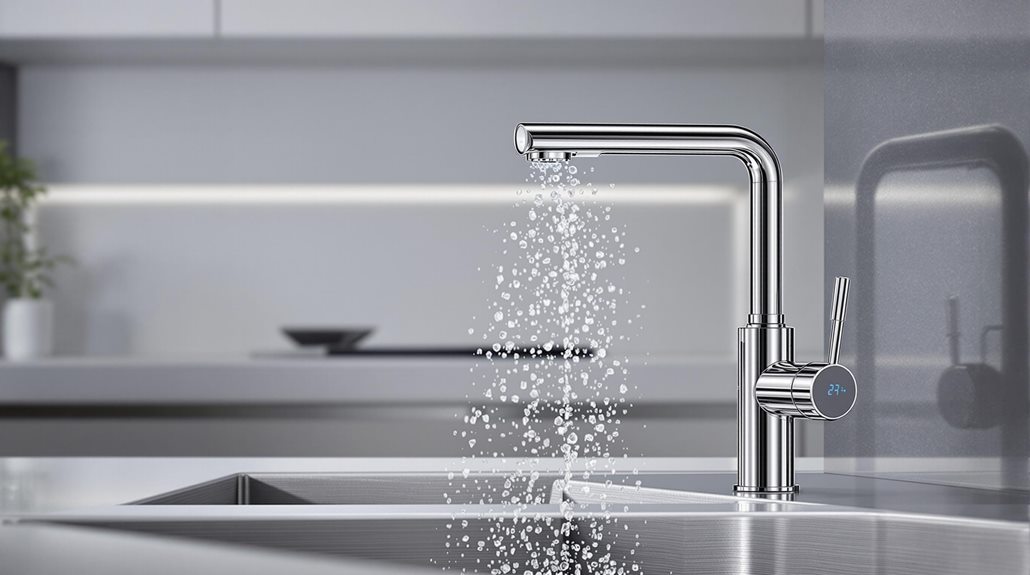
Water-saving technology in smart kitchen sinks delivers impressive conservation results, with advanced sensors and flow control features lowering consumption by up to 30% compared to traditional faucets. You'll find that smart sinks equipped with water sensors and automated shut-off mechanisms can help your household save up to 7,000 gallons annually, substantially reducing your utility bills while supporting environmental conservation.
The advanced water filtration systems integrated into these smart sinks provide you with clean, purified water directly from the faucet. This feature not only guarantees better water quality but also reduces your reliance on bottled water, contributing to broader water conservation efforts. The real-time water usage monitoring helps you track your consumption patterns and make informed decisions about your water efficiency habits.
Cost Analysis and ROI
A smart sink's upfront investment might cause initial sticker shock, with prices ranging from $500 to $1,500 for standard models and exceeding $2,000 for premium options. However, the Waterfall Nano Kitchen Sink and similar models offer features designed to enhance your daily kitchen experience while providing long-term financial benefits. The touchless technology guarantees optimal hygiene, while thermostatic temperature control and Digital Display help you manage water temperature and flow efficiently.
When evaluating the return on investment, consider these key factors:
- Monthly utility savings through precise control water flow and smart home integration, potentially reducing water and energy consumption by 20-30%
- Enhanced property value due to modern features like water purification and automated functions
- Reduced maintenance costs thanks to self-cleaning features and durable materials
- Health-related savings from improved sanitation and reduced cross-contamination risks
While the initial cost may seem steep, the combination of water conservation, energy efficiency, and advanced features can offset your investment over time. Plus, you'll benefit from improved functionality and modern convenience that traditional sinks simply can't match.
Installation Requirements and Process
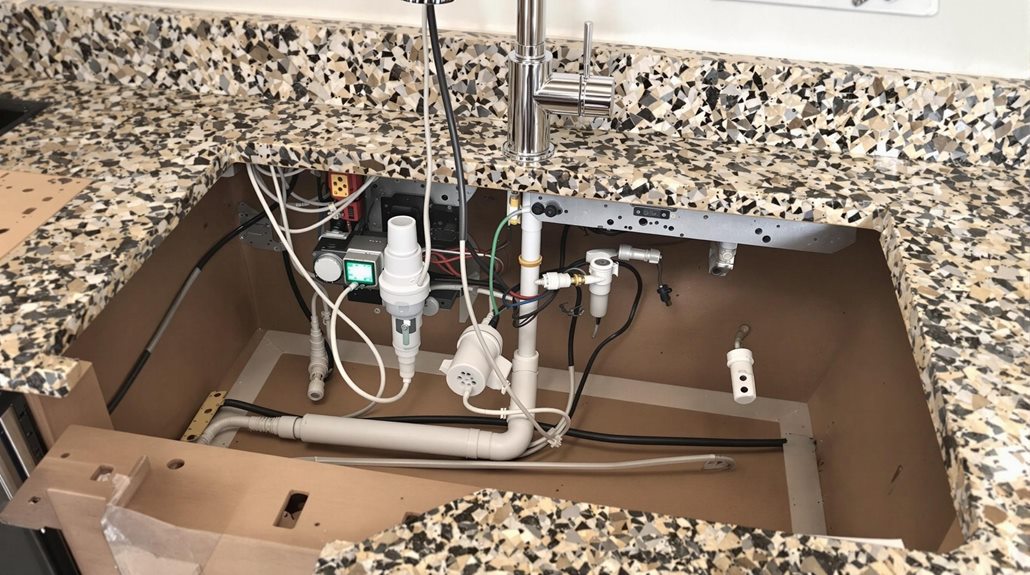
Installing a smart kitchen sink demands careful attention to both electrical and plumbing requirements, making professional installation the recommended choice for most homeowners. When you opt for professional installation, you'll benefit from expert handling of complex connections and receive warranty coverage that protects your investment.
If you're considering a DIY installation, you'll need to carefully evaluate your skills and comfort level with both plumbing and electrical work. Before starting, you'll need to turn off the water supply and gather all necessary tools. Adhering to the manufacturer's instructions precisely is vital, as proper installation directly affects how well your sink's touchless and voice activation features will function.
While DIY installation can save money upfront, it's important to weigh this against the potential risks. Incorrect installation could lead to water damage, electrical issues, or malfunctioning smart features. If you're unsure about any aspect of the installation process, it's best to consult a professional plumber. They'll guarantee your smart sink is installed correctly, all connections are secure, and the system works as intended, giving you peace of mind and reliable performance.
Smart Vs Traditional Sinks
Modern kitchen design has evolved beyond simple faucets and basins, creating a clear divide between smart and traditional sinks. When you're comparing the two options, you'll find that smart sinks offer significant advantages through touchless technology, water conservation features, and precise temperature control. These advanced features deliver enhanced convenience and efficiency that traditional sinks simply can't match.
The key differences between smart and traditional sinks include:
- Water usage optimization - Smart sinks reduce consumption by up to 30% through automatic shut-off and flow control, leading to substantial cost savings on your utility bills
- Hygiene management - Touchless operation and antimicrobial coatings create a more hygienic kitchen environment, unlike traditional sinks that require frequent contact
- Integration capabilities - Smart sinks seamlessly connect with other smart home technologies, while traditional sinks operate in isolation
- Long-term value - Though initially more expensive, smart sinks contribute to increased home value and provide ongoing savings through water conservation
While the upfront investment in smart sinks may reach $1,500 or more, the combination of advanced features, water conservation benefits, and enhanced hygiene makes them an increasingly attractive choice for modern homeowners.
Voice Control and Touchless Operation
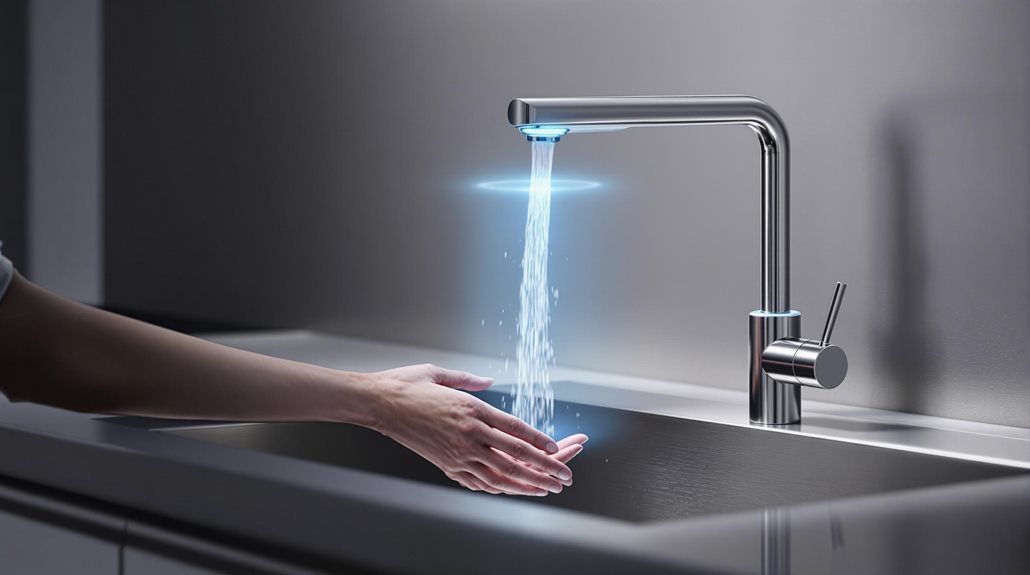
Through the integration of voice control and touchless operation, smart kitchen sinks deliver an unparalleled level of convenience and hygiene. You'll find that these features guarantee a more efficient and cleaner cooking environment, as you won't need to touch the faucet with messy hands while preparing meals. The touchless technology in smart sinks responds to simple motion, automatically activating water flow when you need it most.
Voice control takes convenience even further by allowing you to manage your sink through verbal commands. You can adjust the water temperature and flow without lifting a finger, making multitasking in the kitchen easier than ever. The real-time temperature display and precise temperature control help you achieve the exact water conditions you need for various tasks, from food prep to cleanup.
These advanced control features aren't just about convenience - they're practical solutions that help conserve water by preventing wastage. The faucet automatically shuts off when not in use, and the technology makes the sink more accessible to everyone, including those with mobility challenges. Whether you're cooking, cleaning, or completing other kitchen tasks, these smart features streamline your daily routine.
Maintenance and Long-Term Care
Maintaining a smart kitchen sink requires consistent attention to preserve its innovative features and functionality. You'll need to regularly clean your sink with a soft cloth and mild detergent to keep it looking and performing at its best. To prevent mineral buildup and guarantee optimal water flow, descaling should be part of your maintenance routine. Weekly flushing with hot water helps dissolve accumulated grease and soap scum, maintaining a hygienic environment in your kitchen.
When you encounter issues like sensor malfunctions or unresponsive features, consulting the manufacturer's troubleshooting guide can help you quickly resolve problems. Proper care and maintenance of your smart kitchen sink will drastically extend its lifespan and ensure continued efficient performance.
- Schedule monthly descaling sessions to combat hard water deposits that can affect sensor performance
- Keep a maintenance log to track cleaning schedules and any recurring issues
- Store cleaning supplies specifically designated for your smart kitchen sink nearby
- Learn basic troubleshooting steps to address common problems without requiring professional assistance
These proactive maintenance steps will protect your investment and help you enjoy the full benefits of your smart kitchen sink's advanced features.
Top Brands and Models
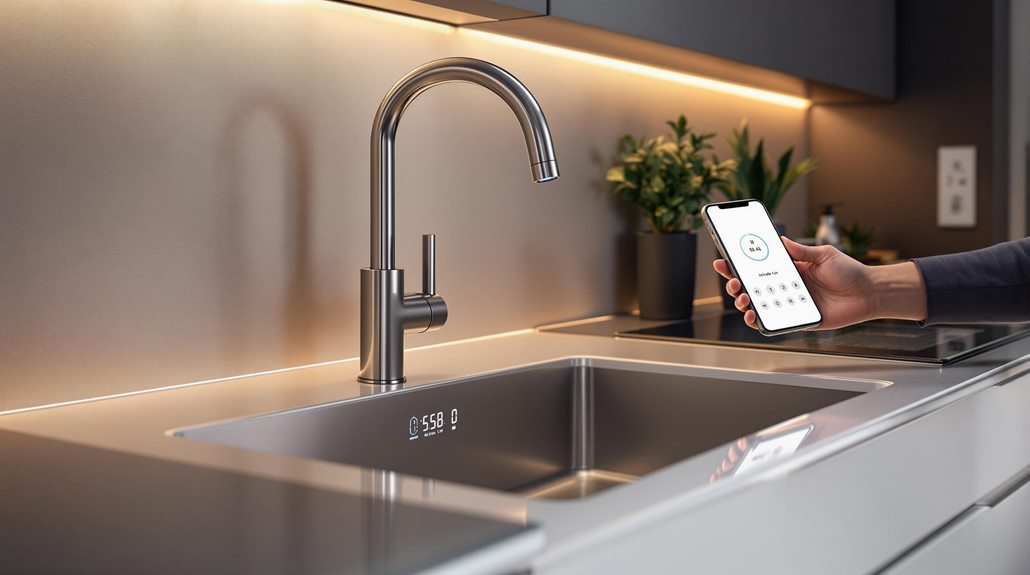
Leading manufacturers have revolutionized kitchen functionality with innovative smart sink designs that combine style and technology. Among the top contenders, Moen's IntelliSink stands out with its thermostatic temperature control and multi-flow faucet capabilities, while their Konnect Sensate takes convenience further by integrating voice control through smart home assistants.
KOHLER's Digital Display Sink brings a modern touch with its real-time temperature display and innovative corrosion-resistant nanotechnology. Their Kohler Konnect line enhances your kitchen experience through touchless technology and app connectivity, helping you achieve better water efficiency while maintaining ideal performance.
If you're looking for a thorough solution, LIPKA's Handmade Waterfall Nano Kitchen Sink offers an integrated design featuring both a pull-out faucet and an RO tap for under-counter water purification. You'll find that these Smart Kitchen Sinks aren't just about aesthetics - they're engineered to streamline your daily routines through intelligent features and intuitive controls. Each brand offers unique advantages, from Moen's voice-activated systems to Kohler's digital displays and LIPKA's all-in-one approach, making it easier for you to choose based on your specific needs and preferences.
Making Your Decision
Now that you're familiar with the top brands and their products, deciding on the right smart kitchen sink involves considering several key factors. While the initial investment of $500-$2,000 might seem substantial, you'll need to weigh the long-term benefits against the upfront costs. Smart kitchen sinks offer advanced features that can alter your daily routine while potentially increasing your home value.
Consider these essential points when making your decision:
- Efficiency Benefits - Look at how water conservation features and temperature control capabilities can reduce your utility bills while supporting environmental sustainability
- Installation Requirements - Evaluate whether you're comfortable with DIY installation or need professional help, as this affects your total investment
- Feature Priority - Determine which smart features matter most to you, from touchless technology to voice activation, ensuring you don't pay for capabilities you won't use
- Integration Potential - Consider how the sink's design and hygienic features will complement your existing kitchen aesthetics and workflow
Remember that smart sinks aren't just about convenience - they're an investment in your home's future, offering practical benefits while staying ahead of modern kitchen trends.




